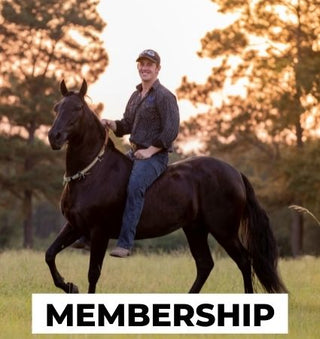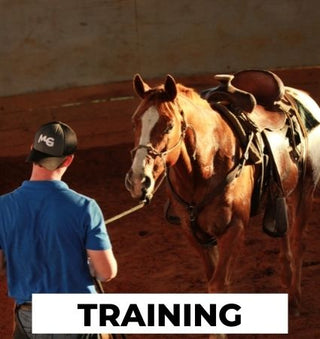Today we are talking about breeching your gaited horses.
Watch the Video Here or continue reading below!
What’s going on guys, it’s Michael Gascon, The Horse Guru and boy do I have some magic for you! If you are a gaited enthusiast that has a gaited horse of any kind, and you’re trying to get them more collected. Shoot, if you have any horse, of any kind, that you’re trying to get collected, do I have some magic for you.
Breeching Helps With Collection
Do you know what this is? You probably don’t, this is a breeching. The breeching you mostly see is on cart and carriage horse. It’s what stops the carriage from running into the back end of the horse. Also, if you’ve seen pack mules, or mountain mules, they carry this a lot. Through the history of the Paso Fino in Colombia they started noticing something with their pack mules that go up and down the mountain. They have a breast collar in the front and this breeching on the back to keep the load in the middle. The people started noticing that their mules were more collected than their horses. Oh my gosh, how could it be a mule more collected than our horses? They started using the same breeching on their horse and it started making the horse more collected.
WHERE TO FIND BREECHING
So, today we are working with this young three-year-old Paso Fino filly and we are just getting to the place where we’re working on gaiting only. She already does obstacles, already does all the things. She’s been through the Respect Series, but now we’re trying to get her to carry herself a certain way.
You can find this three-point breeching at any local Amish shop, cart or carriage shop. I’m going to hook it to the back of the saddle, right here in the middle, always hook it here first. Hook it here first, so that way no matter what she does, if it’s the first time you put it on a horse, they can’t get in a bind. I have seen people on a young horse have it hooked to the girth, on both sides, and undo the center, and then it comes down and hangs back behind their legs. Don’t do that, okay? Now these side straps, they’re going to come over here and they’re going to hook to the top of our girth. We’ll do that on both sides.
Placement Of The Breeching
Whenever I’m setting this up, what I’m looking for, is for this to sit in the center of her rump. She has a dorsal stripe, so it’s awesome and it allows me to center it up real nicely. Then, what I’m looking for, is when I put my hand on the farthest part of her butt here, I want the breeching to be at least a hand below. You see the roundest part of her butt, I put my hand there and make sure there is another hands width below that. I don’t want it so low that it feels like it’s inhibiting her movement. I also don’t want it so high that it slides off. That’s the carriage driver in me.
When I start fitting it to her, in this particular scenario, this is not to stop a carriage. This is to get her gaiting better and get her back end under her. I want to be able to tighten it up. I’m never going to tighten it tighter than the furthest part of her butt. It’s going to be a little under the furthest and largest part of her rear end, but I never want it under that. It should feel about flush, with the farthest part of her rear end.
Tuck That Rear End Under
What’s that going to do ladies? I know, right now I see you in the honky tonk. I’ve been to one or two in my lifetime and you come in there with a pencil skirt on. When you walk in. you walk just like this and all the men are like, that pencil skirt got you collected. That pencil skirt put your feet right up underneath you. That’s exactly what we’re trying to do with this filly.
You can do it the dressage style and spend seven or eight years of pulling on their face and pushing on their on their body looking to make the accordion effect. Over time that absolutely will happen. What we found out with the Paso Finos, and any gaited horse, breeching helps collect them. If you see the bull fighting horses in Spain, they’re very collected. All of them wear the armor so they don’t get gouged. Whenever they’re young, it keeps their butt under them.
ITS LIKE A PENCIL SKIRT
By this horse wearing the breeching, or the pencil skirt if you will, whenever she strides out, if she gets too strung out she feels that touching her butt and she will collect. It doesn’t harm her in any way, if anything it desensitizes her and makes her ready for a mountainside ride. A lot of mountain mule riders use this on their mules. Also, people who work and live in the Grand Canyon and the Appalachian trail use breeching. Those trails are straight up, and straight down. They will put this on their animals to keep their saddle and their packs centered. A byproduct of that is, it can really help collection. It can really make that horse want to put its butt up under itself.
On a young impressionable horse, like this little three-year-old Paso, who has little time under saddle, she’s so impressionable. If we ride her for a month with it, that’s how she’s going to want to carry herself all the time. She will be like she’s a finished show horse and have her butt under her.
IN CONCLUSION ABOUT BREECHING
It desensitizes the horse, keeps your saddle in place, and it’s going to help with your gait. This is because it’s going to get their butt up under them. Thank you guys so much for watching! That’s called breeching, and it works great on gaited horses. Thank you!
Check out more free training resources HERE!









